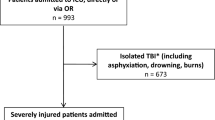Abstract
Background:
The objective of this study was to describe the management of the Jehovah’s Witness (JW) in an intensely active level I trauma center and review the modern therapeutic options available for the trauma care of these patients.
Study design:
A retrospective review of injured JWs admitted to a busy trauma center over a 13-year period was conducted.
Results:
Over the study period, 143 JWs were identified. Among these, 15.4% (22/143) overall and 32.3% (10/31) requiring surgical intensive care unit (SICU) admission accepted transfusion. Overall, 56.6% of JWs (81/143) required operation and 21.7% (31/143) were admitted to the SICU with a complication rate of 4.2% (6/143) and a mortality of 1.4% (2/143). One patient of the 31 patients that were admitted to the SICU received 10 ml of blood with subsequent discontinuation of the transfusion and was excluded from analysis. Of the 30 JWs admitted to the SICU, 20 (66.7%) did not receive transfusion and demonstrated mean admission and nadir hemoglobin (Hb) levels of 12.7 (±2.5) and 9.1 (±3.0) mg/dl, respectively. Ten patients accepted transfusion. This group had longer mean SICU stays (23.3 vs. 5.5 days) but similar mortality (10%, 1/10 vs. 5%, 1/20) compared to non-transfused counterparts. Only one complication (1/20, 5%) was observed in the JWs who were not transfused, compared to a 40% (4/10) complication rate in those accepting transfusion.
Conclusion:
Although our experience was limited, we found no significant difference in the mortality or morbidity between JW patients who received or abstained from transfusion following major trauma. We should keep in mind that the population was small, in order to extract safe conclusions regarding whether we should transfuse or not transfuse trauma patients. We can, however, see interesting insights on the value of trauma resuscitation.
Similar content being viewed by others
References
Varela JE, Gomez-Marin O, Fleming LE, Cohn SM. The risk of death for Jehovah’s Witnesses after major trauma. J Trauma 2003;54:967–72.
Nelson BS, Heiskell LE, Cemaj S, O’Callaghan TA, Koller CE. Traumatically injured Jehovah’s Witnesses: a sixteen-year experience of treatment and transfusion dilemmas at a level I trauma center. J Trauma 1995;39:681–5.
Hébert PC, Wells G, Blajchman MA, Marshall J, Martin C, Pagliarello G, Tweeddale M, Schweitzer I, Yetisir E. A multicenter, randomized, controlled clinical trial of transfusion requirements in critical care. Transfusion Requirements in Critical Care Investigators, Canadian Critical Care Trials Group. N Engl J Med 1999;340:409–17.
Hébert PC, Yetisir E, Martin C, Blajchman MA, Wells G, Marshall J, Tweeddale M, Pagliarello G, Schweitzer I; Transfusion Requirements in Critical Care Investigators for the Canadian Critical Care Trials Group. Is a low transfusion threshold safe in critically ill patients with cardiovascular diseases? Crit Care Med 2001;29:227–34.
Malone DL, Dunne J, Tracy JK, Putnam AT, Scalea TM, Napolitano LM. Blood transfusion, independent of shock severity, is associated with worse outcome in trauma. J Trauma 2003;54:898–905; discussion 905-7.
Vincent JL, Baron JF, Reinhart K, Gattinoni L, Thijs L, Webb A, Meier-Hellmann A, Nollet G, Peres-Bota D; ABC (Anemia and Blood Transfusion in Critical Care) Investigators. Anemia and blood transfusion in critically ill patients. JAMA 2002;288:1499–507.
Low LL, Harrington GR, Stoltzfus DP. The effect of arterial lines on blood-drawing practices and costs in intensive care units. Chest 1995;108:216–9.
Lu YQ, Cai XJ, Gu LH, Wang Q, Huang WD, Bao DG. Experimental study of controlled fluid resuscitation in the treatment of severe and uncontrolled hemorrhagic shock. J Trauma 2007;63:798–804.
Bickell WH, Wall MJ Jr, Pepe PE, Martin RR, Ginger VF, Allen MK, Mattox KL. Immediate versus delayed fluid resuscitation for hypotensive patients with penetrating torso injuries. N Engl J Med 1994;331:1105–1109.
Majeski J. Advances in general and vascular surgical care of Jehovah’s Witnesses. Int Surg 2000;85:257–65
Victorino G, Wisner DH. Jehovah’s Witnesses: unique problems in a unique trauma population. J Am Coll Surg 1997;184:458–68.
Kulvatunyou N, Heard SO. Care of the injured Jehovah’s Witness patient: Case report and review of the literature. J Clin Anesth 2004;16:548–53.
Detry O, De Roover A, Honore P. Prevention and treatment of major blood loss. N Engl J Med 2007;357:1261; author reply 1261.
Haan J, Scalea T. A Jehovah’s Witness with complex abdominal trauma and coagulopathy: use of factor VII and a review of the literature. Am Surg 2005;71:414–5.
Marino PL. The ICU Book, 3rd edn. Lippincott Williams & Wilkins, Philadelphia, PA, USA, 2007; p 68.
Hashem B, Dillard TA. A 44-year-old Jehovah’s Witness with life-threatening anemia from uterine bleeding. Chest 2004;125:1151–4.
Corwin HL, Gettinger A, Pearl RG, Fink MP, Levy MM, Shapiro MJ, Corwin MJ, Colton T; EPO Critical Care Trials Group. Efficacy of recombinant human erythropoietin in critically ill patients: A randomized controlled trial. JAMA 2002;288:2827–35.
Author information
Authors and Affiliations
Corresponding author
Rights and permissions
About this article
Cite this article
Georgiou, C., Inaba, K., DuBose, J. et al. Optimizing Outcomes in the Jehovah’s Witness Following Trauma: Special Management Concerns for a Unique Population. Eur J Trauma Emerg Surg 35, 383–388 (2009). https://doi.org/10.1007/s00068-009-8246-6
Received:
Accepted:
Published:
Issue Date:
DOI: https://doi.org/10.1007/s00068-009-8246-6




